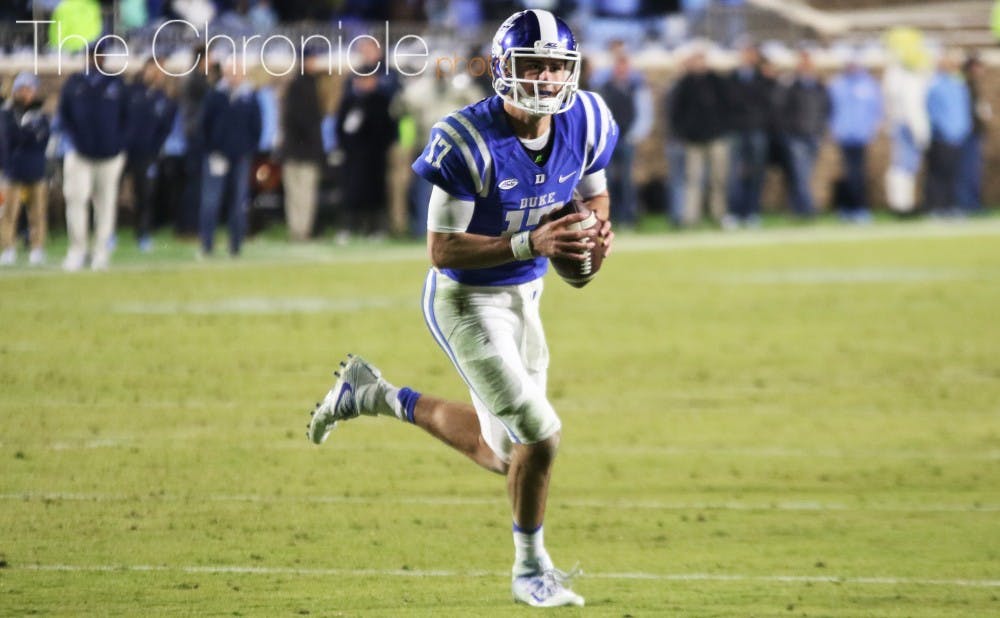Following Duke's 4-8 season, The Chronicle will evaluate the Blue Devils' offense, defense and special teams this week, starting with the offense today. Check back later this week for our grades for Duke's other units and how the team can improve going forward.
Offense: B-
Pass: Everything changed for the Blue Devils Aug. 26—one week before their first regular season matchup—when starting quarterback Thomas Sirk re-injured his Achilles tendon in practice, sidelining him for the season. Sirk’s injury forced Duke’s hand, as redshirt freshman quarterback Daniel Jones was slotted into the position, and the season opened with low expectations in the passing game, especially after losing key pass-catchers Max McCaffrey and Braxton Deaver to graduation. As expected, the first-year signal-caller was shaky early on—including a five-interception performance in a 34-20 loss to Virginia in Durham—but improved as the season progressed, finishing the year with only one interception in the last seven games.
Sirk was not the only threat lost in the passing game, as senior wide receiver Anthony Nash missed the entire second half of the season with a broken clavicle. At the time of the injury, Nash was Duke’s leading receiver and Jones’ favorite target on third down, using his 6-foot-5 frame to reel in passes over the middle of the field.
In Nash’s absence, a few different players stepped up to help Jones continue growing into his role. Sophomore wideout T.J. Rahming had a strong finish to the season, with at least 100 receiving yards in each of Duke’s last three games, and tight ends Erich Schneider, Daniel Helm and Davis Koppenhaver all improved as well, with Koppenhaver catching the go-ahead touchdown in Duke’s 28-27 upset against then-No. 15 North Carolina.
Despite his shaky start to the season, Jones cemented his status as the Blue Devils’ quarterback of the future, even with Sirk returning next season after being granted a medical redshirt. Jones also played behind a shaky offensive line that surrendered 31 sacks and had to manage a beleaguered offensive unit, but he still finished the season with a 62.8 completion percentage, 2,836 passing yards and 16 touchdowns with nine interceptions.
Rush: After Sirk went down, the rushing attack was expected to shoulder the majority of the burden, putting Duke in favorable third-down scenarios to ease Jones into game action. With two preseason Doak Walker award watch list selections in Jela Duncan and Shaun Wilson, it was a fair assumption that the Blue Devils would lean on their run game to take pressure off of Jones.
But the running back duo did not live up to the hype. Duncan was effective but was saddled with injuries throughout the season. The redshirt senior captain did not play against Virginia Oct. 1 before suffering a season-ending leg injury in the Blue Devils’ 38-35 loss against Georgia Tech Oct. 29. Still, Duncan was Duke’s best option when he was on the field, averaging 5.1 yards per carry with six touchdowns.
When Duncan went down, both Wilson and Jones received the majority of the carries, and they combined for more than 150 yards in three consecutive games against the Yellow Jackets, Virginia Tech and the Tar Heels. But they both struggled in the final two games of the season, especially after redshirt junior offensive lineman Gabe Brandner left the Blue Devils’ 56-14 loss at Pittsburgh, as Duke had to rely on its passing game more than it would have preferred this season.
X's and O's: Throughout the season, first-year offensive coordinator Zac Roper was relatively conservative in his play calls, but he opened up the playbook in victories against Notre Dame and North Carolina. As the season progressed, Roper’s confidence in Jones’ passing abilities showed, as the first-year signal-caller attempted at least 30 passes in the last five games of the season.
Because Duncan, Wilson and running back Joseph Ajeigbe were not always effective running the ball on first and second down, Jones was forced into many unfavorable passing situations, and to make matters worse, he lacked a true downfield target.
The lack of playmakers harmed the offense's production, and the Blue Devils finished the season ranked 112th in scoring offense, averaging only 23.3 points per game. But despite the disappointing season, Jones proved his mettle as Duke’s starting quarterback of the future, and will only continue to grow with a largely inexperienced group of receivers surrounding him.
Get The Chronicle straight to your inbox
Signup for our weekly newsletter. Cancel at any time.

